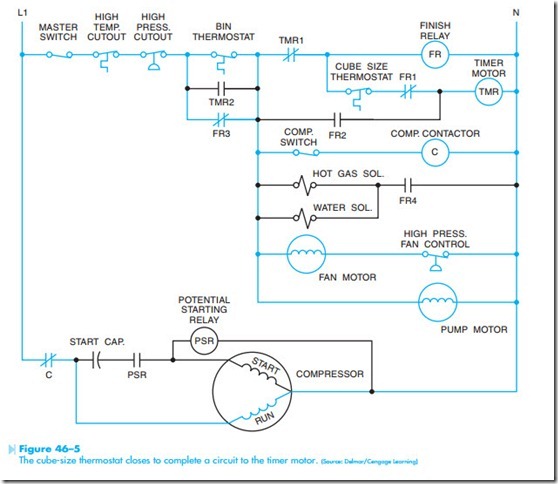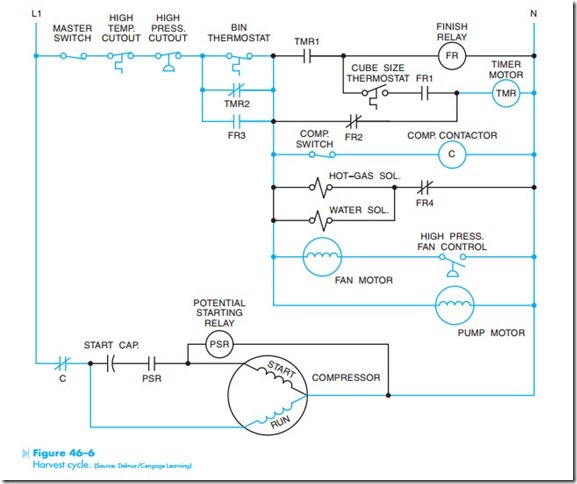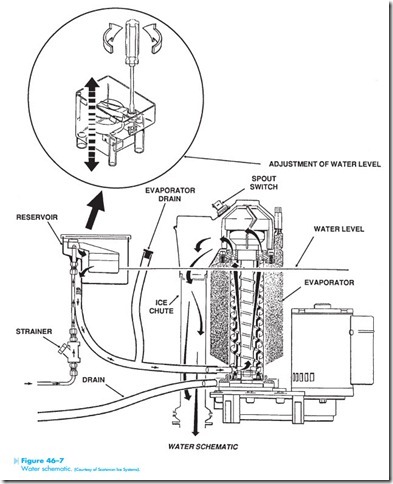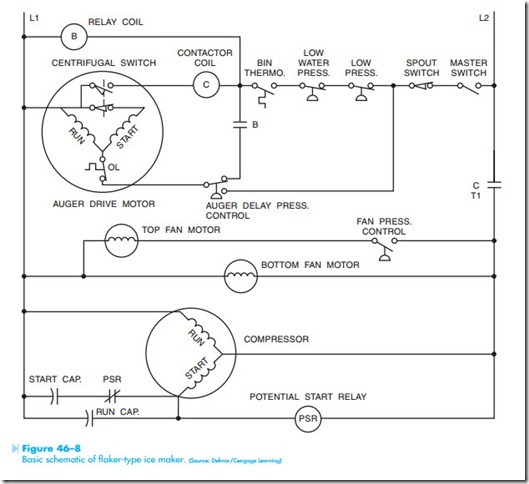FLAKER-TYPE ICE MAKERS
Flaker-type ice makers produce ice continuously as opposed to harvesting ice cubes at certain intervals. Flaked ice has a soft, flaky texture and is often preferred by restaurants. A basic diagram of a flaker-type ice maker is shown in Figure 46–7. The water supply from the building enters the water reservoir. A float valve maintains a constant water level in the reservoir.
Water from the reservoir enters the bottom of the freezer assembly. The freezer assembly is the evaporator of the refrigeration unit. The freezer assembly is basically a hollow tube surrounded by a cylindrical container. Refrigerant is used to cool the hollow tube. A stainless steel auger is placed inside the hollow tube. The motor drive assembly turns the auger. As water enters the bottom of the freezer assembly, it is frozen into ice and carried upward by the auger. When the ice reaches the top, the flared end of the auger presses excess water out of the ice before it is extruded or flaked out through
the ice spout. A nylobraid tube carries the ice to the ice storage bin. When enough ice accumulates, it touches the sensor bulb of the bin thermostat. The bin thermostat contact then opens and the compressor is disconnected from the line, but the auger drive motor continues to operate for approximately 1 to 2 minutes. This permits the auger to clear the ice out of the freezer unit before it stops operating.
The basic schematic diagram for the flaker-type ice maker is shown in Figure 46–8. Notice that the auger drive motor contains two separate centrifugal
switches, one normally closed and the other normally open. The normally closed switch connects the motor start winding to the line when the motor is started. The normally open centrifugal switch controls the coil of the compressor contactor. The compressor contactor can be energized only when the auger drive motor operates within a certain speed range. If ice becomes compacted in the freezer unit, it will cause the auger drive motor to slow down. If the speed of the auger drive motor is reduced below a certain point, the centrifugal switch connected in
series with the compressor contactor coil will open. If this should happen, the compressor turns off, but the auger delay pressure control switch permits the auger to continue operating for approximately one and a half minutes. If the ice is cleared sufficiently in that length of time, the auger drive motor speed will increase and permit the centrifugal switch to reclose and start the compressor.
The auger delay pressure control switch is a single-pole double-throw pressure switch connected in the low side of the refrigeration system. When the system is turned off, and the pressures have equalized in the system, the low-side pressure is high enough to hold the switch in the position shown in Figure 46–8. When the compressor starts, the low-side pressure begins to decrease. When it has decreased to 20 psig (pounds per square inch gauge), the contacts change position. They will remain in the changed position until the low-side pressure increases to 32 psig.
The bin thermostat senses the level of ice in the storage bin and normally controls the operation of
the ice maker. A low water-pressure switch is connected to the water supply line. If the water pressure drops below 5 psig, the switch contacts will open. They will reclose when the water pressure reaches 20 psig. The low head-pressure switch can interrupt operation of the compressor if the head pressure should become too low.
A master switch disconnects power to the entire control circuit. The spout switch can also disconnect power to the entire circuit in case the ice becomes compacted in the nylobraid tube and spout. If the spout switch becomes tripped, it must be manually reset.
This unit utilizes two condenser fan motors. One motor is mounted at the bottom of the condenser and the other is mounted at the top. The bottom fan motor is connected in parallel with the compressor and will operate any time the compressor is in operation. The top fan motor is controlled by a pressure switch that senses the high side of the refrigeration system. If the pressure becomes high enough, the




